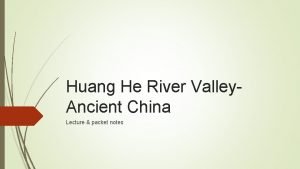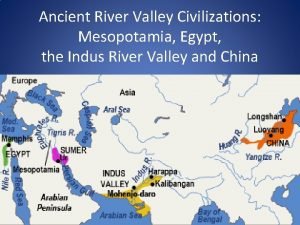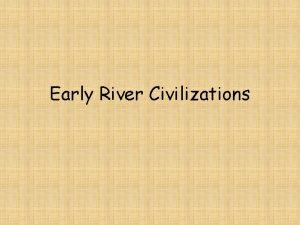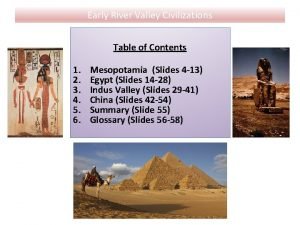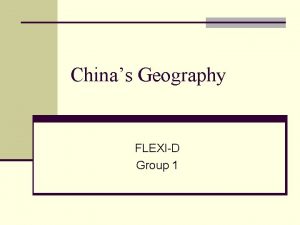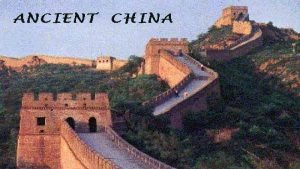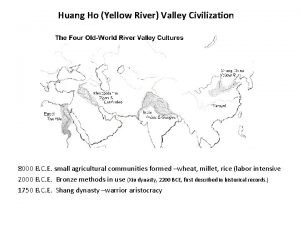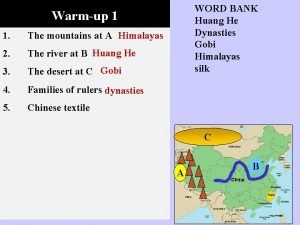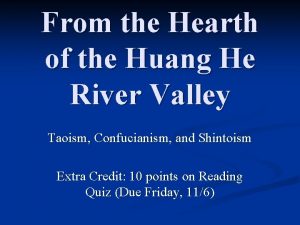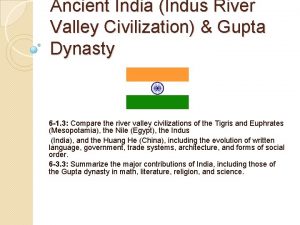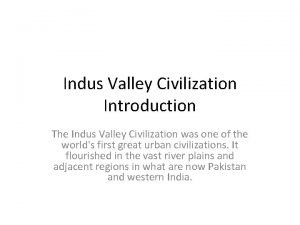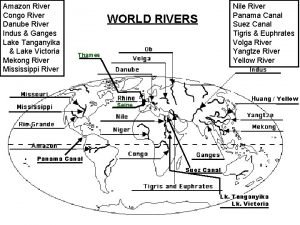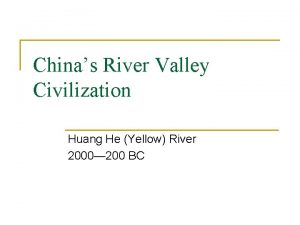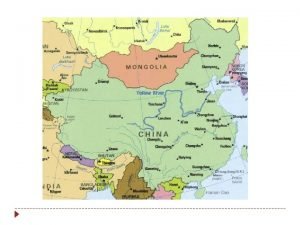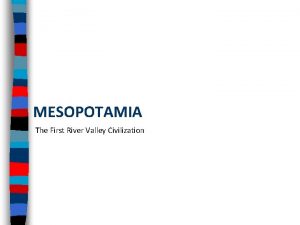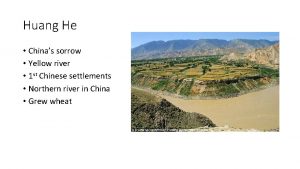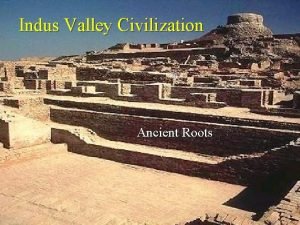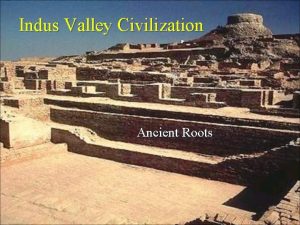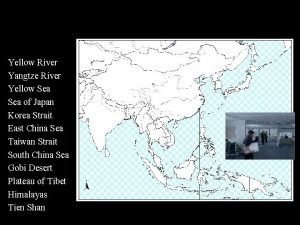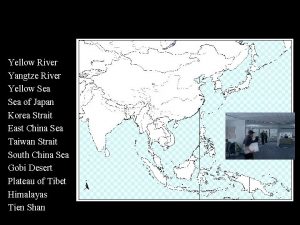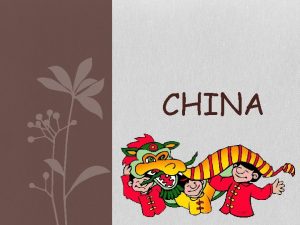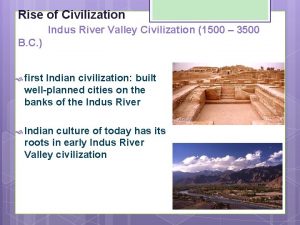Chinas River Valley Civilization Huang He Yellow River















- Slides: 15

China’s River Valley Civilization Huang He (Yellow) River 2000— 200 BC

Geography of China n Natural Barriers q q q Gobi and Taklimakan Deserts to north and west Yellow Sea, Pacific Ocean, East China Sea to east Himalayas Mountains and Plateau of Tibet to southeast

China

River Systems n Two Major Systems q Huang He (Yellow) n n n In north, flowing from mountains in west to Yellow Sea Called “Yellow” because of yellow silt (Loess, pronounced “loh-us”) Silt-laden river floods every year q q q Chiang Jiang (Yangtze) Further south, flowing from Tibetan Plateau Only 10% of China’s land is suitable for Agriculture. 90% of that land is between Huang He and Chiang Jiang Rivers. n n Good fertilizer Dangerous – “China’s Sorrow”

Early Chinese n n n Fossil remains date to 1. 7 million years ago (Southwestern China) Huang He River Valley settled 500, 000 years ago (Peking Man) Before Mesopotamia, farming settlements along Huang He 3000 BC Lungshan people started harvesting silkworms, using potter’s wheel, baking bricks in ovens 2000 BC First cities develop along Huang He

China n n n n Loess- fertile yellow-brown soil, carried by wind Dynasty- ruling family Mandate of Heaven- heaven granted the ruler the right to rule. People owed the ruler loyalty and obedience Feudalism- mode of production where king provides land, protection, people provide labor, soldiers Pictograph- writing- pictures or objects Ideograph- writing- symbols represent ideas Yin Yang- opposing forces that balance each other


n n n Dates 2033 -1562 B. C. 1562 -1066 B. C. 1066 -771 B. C. 770 -256 B. C. 770 -476 B. C. 475 -221 B. C. 221 -207 B. C. 206 B. C. -A. D. 8 A. D. 9 -25 A. D. 25 -220 Dynasty Xia Shang Western Zhou Eastern Zhou Spring and Autumn Period Warring States Period Qin Western Han Xin Eastern Han Duration 441 655 295 514 294 254 14 214 16 195

q Xia Dynasty, (semi-legendary) n n Shang Dynasty q q q n Yu--first leader: Mathemetician, engineer Developed Flood Control and Irrigation Systems Increased agricultural output allowed cities to grow even larger Confirmed by Archeological Evidence Came to power with overthrow of last Xia emperor Major Cities: Erligang, Chang-an, Anyang Han Dynasty (longest q q Replaced Qin (which had built the Great Wall) Established Centralized Government n n n q Complex bureaucracy 130, 000 Civil Servants in 18 ranks Yearly Civil Service exams Expanded China with military conquests

Shang and Chou Class Structure n Kings and nobles: q q lived in large homes and palaces, Bronze tools and wares, wore elaborate gowns of silk buried in lavish tombs n n Warriors: The leaders of different clans were continually waging war with each other. q Warriors were knights n n n Unlike the ancient Egyptians, the Shang and Chou were buried with living people. In their tombs, archaeologists have found entire chariots, objects of art, and the remains of guards and dogs who accompanied kings to their graves. bronze armor horse-drawn chariots Farmers: Most people were farmers (peasants). q Farmers lived in nearby villages. n n n Summer homes made of bamboo branches near fields. Winter homes in village made of mud, one room houses, thatched roofs Small plots q q q • did not own the land, it was assigned to them by the royals and the nobles. They had to give the nobleman part of the food they grew. They worked without pay on the noble's house, roads, and bridges. Merchants and Craftsmen: • • • Did not produce food + not part of the nobility = outside the class structure. Like slaves, they were hardly considered human. In times of war, when the city was attacked, they were not taken inside the protective walls, but were left to fend for themselves as best they could.

Early Chinese Religion n n Gods of nature: the river god, the rain god, the earth god, etc. Most powerful was the sky god, T'ien, the king of gods. Ancestor Worship: Spirits of family ancestors could bring good or bad fortune. “Like troublesome or helpful neighbors” who demanded attention and respect. q Continued to modern times

Confucianism n Confucius (born 551 BC) q q Scholar/Teacher Wrote Analects— n n n q Five basic relationships: (Ruler-Subject, father-son, husband-wife, older-younger brother, friend-friend) Different rules of behavior depends on which relationship (Example) Filial Piety: devotion to one’s parents during their lifetime and honoring their memory after. Not a Religion, but the Ethical System Which became the basis of Chinese Government and Social Order.

Early Chinese Cities n n n Only about 10% of the population lived in the cities. Cities were neatly laid out with main streets and alleyways. Surrounded by a strong wall, made of earth and stone. Centers of government, education, and trade. Erligang: q Surrounded by a large wall -- 7 km around. q Workshops were located outside of the city walls n n bone workshop a pottery workshop bronze vessel workshops. Erligang Capital city, there were several over the years q Ch'ang-an, >1 million people! q Checkerboard design. q 110 blocks, each like its own village, with a marketplace and temples.

Advanced Technology in China n n Coined money (later paper money) Blast furnaces for Iron working q q n n n n Improved iron farm tools increased productivity Better military weapons Highway network (4000 miles) Standardized weights & measures, currency Paper (AD 105) Collar Harness for draft animals 2 bladed iron plow Wheelbarrow Water mills for grinding grain

The Great Wall of China
 Hwang ho civilization
Hwang ho civilization 4 river valley civilizations
4 river valley civilizations River valley civilization
River valley civilization Mesopotamia technology
Mesopotamia technology Ancient river valley civilizations map
Ancient river valley civilizations map Whats chinas longest river
Whats chinas longest river Huang ho valley
Huang ho valley Huang ho valley
Huang ho valley Where is the huang he river
Where is the huang he river Shinto hearth
Shinto hearth Huang he river
Huang he river Ebers papyrus
Ebers papyrus Caste system in indus valley civilization
Caste system in indus valley civilization Introduction of indus valley civilization
Introduction of indus valley civilization Under 70
Under 70 River indus
River indus
